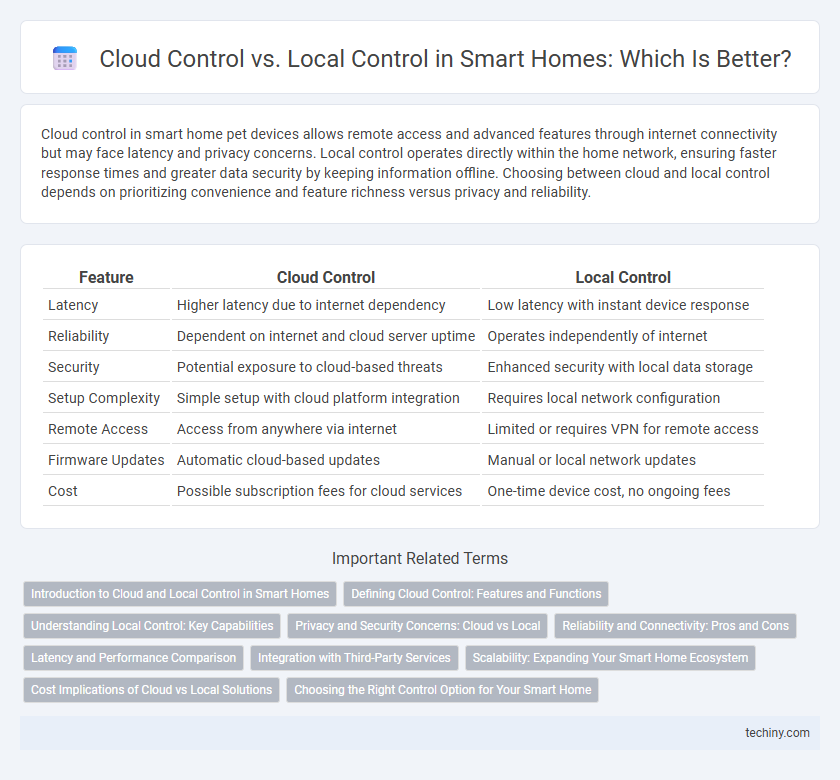Cloud control in smart home pet devices allows remote access and advanced features through internet connectivity but may face latency and privacy concerns. Local control operates directly within the home network, ensuring faster response times and greater data security by keeping information offline. Choosing between cloud and local control depends on prioritizing convenience and feature richness versus privacy and reliability.
Table of Comparison
| Feature | Cloud Control | Local Control |
|---|---|---|
| Latency | Higher latency due to internet dependency | Low latency with instant device response |
| Reliability | Dependent on internet and cloud server uptime | Operates independently of internet |
| Security | Potential exposure to cloud-based threats | Enhanced security with local data storage |
| Setup Complexity | Simple setup with cloud platform integration | Requires local network configuration |
| Remote Access | Access from anywhere via internet | Limited or requires VPN for remote access |
| Firmware Updates | Automatic cloud-based updates | Manual or local network updates |
| Cost | Possible subscription fees for cloud services | One-time device cost, no ongoing fees |
Introduction to Cloud and Local Control in Smart Homes
Smart homes leverage cloud control to enable remote access, data storage, and processing through internet-connected servers, offering seamless integration with voice assistants and real-time updates. Local control operates independently from the internet by managing devices via in-home hubs or direct connections, ensuring faster response times and enhanced privacy. Choosing between cloud and local control depends on factors like latency tolerance, data security priorities, and system complexity in smart home environments.
Defining Cloud Control: Features and Functions
Cloud control in smart home systems enables remote management and automation of devices through internet-connected servers, offering features like real-time updates, multi-device synchronization, and voice assistant integration. It facilitates secure data storage and advanced analytics for optimizing energy use and enhancing home security. Cloud control supports seamless scalability and cross-platform compatibility, making it ideal for dynamic smart home environments requiring constant connectivity.
Understanding Local Control: Key Capabilities
Local control in smart homes enables devices to operate independently of internet connectivity, ensuring faster response times and enhanced privacy. Key capabilities include direct communication between devices through protocols like Zigbee, Z-Wave, or Bluetooth, enabling real-time automation and reliable performance. This control method reduces latency and dependence on external servers, improving overall system resilience and security.
Privacy and Security Concerns: Cloud vs Local
Local control offers enhanced privacy by processing data directly within the home network, minimizing exposure to external threats and reducing reliance on internet connectivity. Cloud control enables remote access and advanced AI features but raises concerns over data interception, unauthorized access, and vendor dependency. Prioritizing end-to-end encryption and stringent access controls is critical to safeguarding smart home systems regardless of the control method.
Reliability and Connectivity: Pros and Cons
Cloud control in smart homes offers seamless remote access and integration with multiple devices through internet connectivity, but it risks disruptions during outages and potential latency issues. Local control enhances reliability by managing devices within the home network, ensuring faster response times and uninterrupted operation even without internet access. However, local control may lack the scalability and extensive third-party compatibility found in cloud-based solutions.
Latency and Performance Comparison
Cloud control in smart home systems often experiences higher latency due to data transmission to remote servers, which can delay command execution and reduce real-time responsiveness. Local control processes data within the home network, significantly lowering latency and enhancing performance by enabling instant device communication without internet dependency. Prioritizing local control can improve system reliability and speed, especially for time-sensitive applications like security and lighting automation.
Integration with Third-Party Services
Cloud control enables seamless integration with a wide range of third-party services through internet connectivity, offering expansive compatibility with platforms like Alexa, Google Assistant, and IFTTT. Local control provides faster response times and enhanced privacy but may face limitations in integrating external services due to the absence of constant internet access. Choosing between cloud and local control depends on whether extensive third-party collaboration or data security and latency are prioritized in the smart home setup.
Scalability: Expanding Your Smart Home Ecosystem
Cloud control enables easy scalability by allowing seamless integration of new devices without complex local infrastructure upgrades. Local control offers faster response times but may require significant hardware expansion to support additional smart home products. For expansive smart home ecosystems, cloud-based solutions provide greater flexibility and scalability to manage numerous connected devices efficiently.
Cost Implications of Cloud vs Local Solutions
Local control systems generally incur higher upfront costs due to hardware installation and maintenance but reduce ongoing expenses by minimizing cloud service fees and subscription costs. Cloud control solutions often have lower initial investments but involve continuous operational costs, including data storage, bandwidth, and platform subscription charges. Evaluating total cost of ownership requires comparing the fixed expenses of local infrastructures against the scalable, usage-based pricing of cloud services in smart home automation.
Choosing the Right Control Option for Your Smart Home
Choosing the right control option for your smart home depends on factors like reliability, privacy, and convenience. Cloud control offers remote access and integration with voice assistants but relies on internet connectivity, potentially raising privacy concerns. Local control provides faster response times and enhanced security by processing commands within your home network, making it ideal for critical automation tasks.
Cloud Control vs Local Control Infographic

 techiny.com
techiny.com